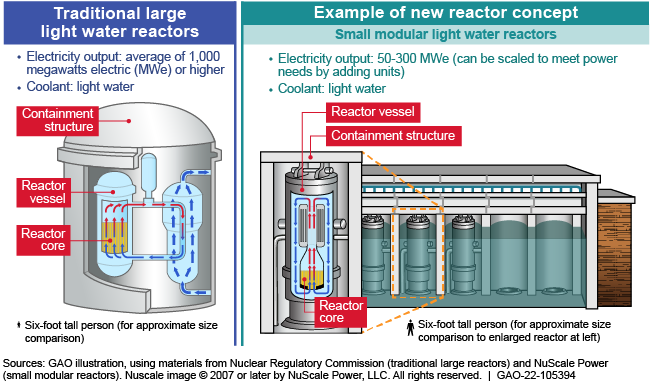Nuclear Energy Projects: DOE Should Institutionalize Oversight Plans for Demonstrations of New Reactor Types [Reissued with revisions on Sept. 15, 2022]
Fast Facts
Nuclear power plants account for about 20% of the electricity and half of the carbon-free electricity generated in the U.S. However, plants are aging and economic challenges have led to closures and planned shutdowns.
In FY 2021, the Department of Energy made 3 awards totaling $4.6 billion to support development of new reactor types that are expected to bring improvements.
To monitor projects, DOE uses practices such as milestone tracking. It plans to add additional practices—such as independent reviews—to oversee awards. DOE could do more to ensure these practices will be consistently used. Our recommendation addresses this issue.
Example of new reactor concept

On September 15, 2022, comment letters from the Department of Energy and the Nuclear Regulatory Commission were added in appendices III and IV, respectively. Corrections are on pages 25-26, and page 27.
Highlights
What GAO Found
The Department of Energy (DOE) supports the research, development, and demonstration of new types of nuclear reactors. In line with that role, in fiscal year 2021, the department made three multi-year awards totaling $4.6 billion to support the demonstration of one small modular reactor and two advanced reactors. DOE awarded the Carbon Free Power Project about $1.4 billion for a small modular reactor plant near Idaho Falls, Idaho. Under the Advanced Reactor Demonstration Program, DOE awarded TerraPower almost $2 billion for the NatriumTM Demonstration in Wyoming and awarded X-energy about $1.2 billion for the Xe-100 Demonstration in Washington State.
DOE has taken several actions to manage risks associated with the three demonstration awards, including using project management practices such as budget controls and milestone tracking. The two DOE offices managing the awards—the Offices of Nuclear Energy and Clean Energy Demonstrations—also plan to use additional project management practices, such as external independent reviews, to oversee the awards (see fig.). Office of Clean Energy Demonstrations officials said these additional project management practices will apply to all large DOE energy demonstration awards, regardless of which DOE offices are managing those awards. However, neither office has institutionalized its plans by documenting these additional project management practices. Documenting these processes, including the use of external independent reviews, would allow DOE to share best practices across offices during the course of these multi-year awards, potentially resulting in stronger federal oversight of the projects and improved project performance.
Existing and Planned Project Oversight Processes for Nuclear Energy Demonstration Awards, as of June 2022

Why GAO Did This Study
In 2021, nuclear energy accounted for almost 20 percent of the nation's electricity generation and provided about 50 percent of the carbon-free electricity. However, economic challenges have led to the closure or planned shutdown of multiple nuclear power plants. To address these challenges, DOE has made awards to projects that demonstrate first-of-a-kind small modular and advanced reactors. These are either smaller than existing reactors or use technologies expected to offer improvements over the most recent generation of nuclear reactors. According to DOE, the federal government has a unique role to play in reducing the financial and technical risks faced by companies seeking to develop these technologies.
GAO was asked to review DOE's management of nuclear energy demonstration awards. This report (1) describes awards DOE has made to support the demonstration of small modular and advanced reactors; and (2) examines actions DOE is taking to manage risks associated with awards.
To do this work, GAO assessed DOE's management of the awards against laws, regulations, guidance, and leading project management practices. GAO also interviewed DOE program and project management officials, awardees, and industry stakeholders.
Reissued with revisions on Sept. 15, 2022
On September 15, 2022, comment letters from the Department of Energy and the Nuclear Regulatory Commission were added in appendices III and IV, respectively. Corrections are on pages 25-26, and page 27.Recommendations
GAO is recommending that DOE institutionalize via documentation its processes for providing oversight for large nuclear energy demonstration projects, including the use of external independent reviews. DOE agreed with GAO's recommendation.
Recommendations for Executive Action
| Agency Affected | Recommendation | Status |
|---|---|---|
| Department of Energy |
Priority Rec.
The Secretary of Energy should ensure that the Assistant Secretary for Nuclear Energy and the Director of the Office of Clean Energy Demonstrations coordinate and institutionalize via documentation their processes for providing oversight for large nuclear energy demonstration projects, including the use of external independent reviews, steps for addressing any risks identified, and criteria for which projects should use these processes. (Recommendation 1) |
DOE agreed with our recommendation. In its response to our report, DOE's Offices of Nuclear Energy and Clean Energy Demonstrations stated that they are taking steps to document their processes for providing oversight of large nuclear demonstration projects--including the use of external independent peer reviews--and for ensuring close cooperation. In March 2024, DOE officials said that they drafted and submitted draft procedures for independent peer reviews to management and determined additional efforts are required, including additional procedures on the topics of risk management, independent cost reviews, and general award oversight. DOE officials also said that draft procedures for these additional elements are being prepared for management review by the end of the third quarter of 2024. Finalizing documentation of these processes will allow DOE to share best practices across offices, which could result in stronger federal oversight of the projects and improved project performance. Further, because the Office of Clean Energy Demonstrations will oversee other large energy demonstration projects going forward, documenting these processes could result in stronger federal oversight, more broadly.
|
